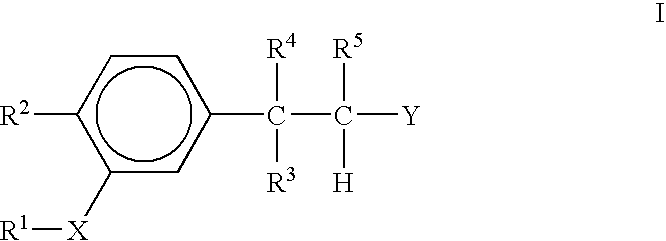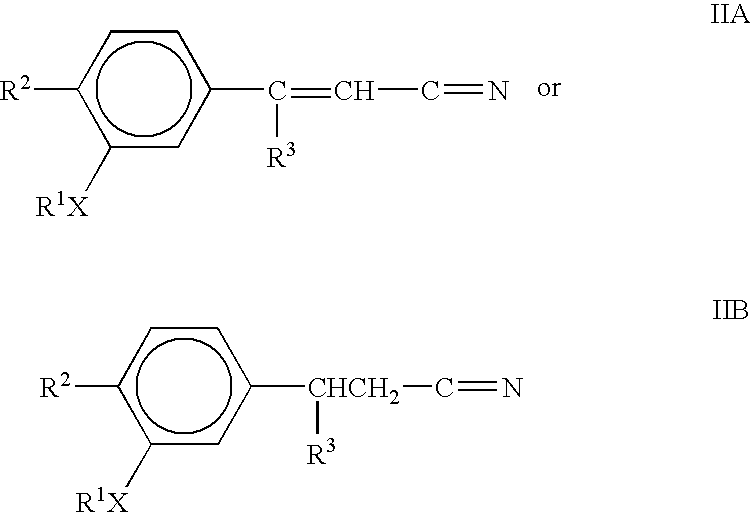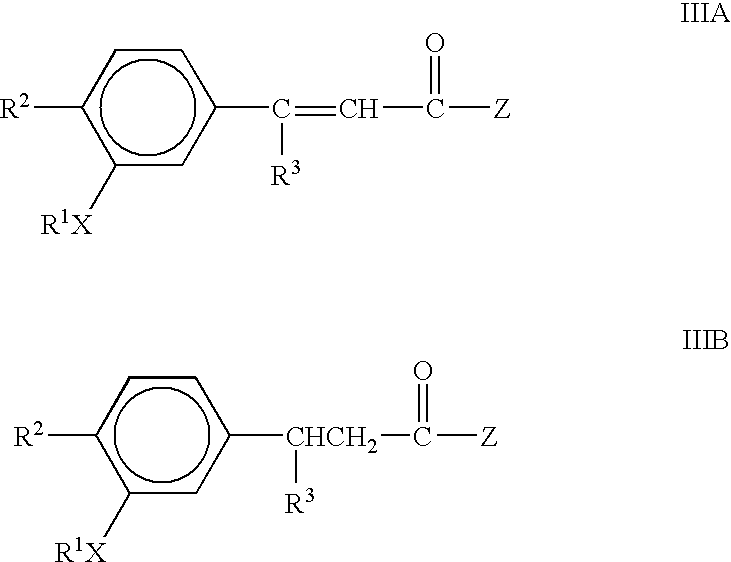Immunotherapeutic agents
a technology of immunotherapy and immunomodulatory agent, applied in the field of immunomodulatory agent, can solve the problems of impaired immune system of t-cells and severe opportunistic infections of infected individuals
- Summary
- Abstract
- Description
- Claims
- Application Information
AI Technical Summary
Problems solved by technology
Method used
Image
Examples
example 1
3,3-bis-(3,4-Dimethoxyphenyl)acrylonitrile
A. 3,4,3′,4,′-Tetramethoxybenzophenone
[0061]To a stirred ice bath cooled solution of veratole (2.07 g, 15.0 mmol) in 30 mL of methylene chloride under nitrogen was added aluminum chloride (2.20 g, 16.5 mmol). A slight exotherm resulted. To the reaction mixture was then added 3,4-dimethoxybenzoyl chloride (3.01 g, 15.0 mmol) and 20 mL of methylene chloride. The reaction was then allowed to warm to room temperature and then refluxed for 3.5 hours and then allowed to stir at room temperature for 16 hours. The reaction mixture was then poured into 50 mL of ice water and stirred for 15 minutes. This mixture was extracted with methylene chloride (2×25 mL each). The combined extracts were dried over sodium sulfate and concentrated in vacuo to afford the crude product as a tan solid. The crude product was purified by flash chromatography (silica gel, 4 / 96 ethyl acetate / methylene chloride) to afford 2.97 g (66%) of the product as a white powder: 1H N...
example 2
cis and trans 3-(3,4-Dimethoxyphenyl)-3-(3-ethoxy-4-methoxyphenyl)acrylonitrile
A. 3,4-Dimethoxy-3-ethoxy-4-methoxybenzophenone
[0063]To an ice bath cooled stirred suspension of 3-ethoxy-4-methoxybenzoic acid (0.98 g, 5.0 mmol) in 20 mL methylene chloride was added oxalyl chloride (0.44 mL, 5.0 mmol) and 2 drops of N,N dimethylformamide (dimethylformamide). The resulting yellow mixture was stirred at room temperature for 35 minutes at which time a solution had formed. The solution was cooled in an ice bath and veratrole (0.64 mL, 5.0 mmol) was added followed by aluminum chloride (0.73 g, 5.5 mmol). The ice bath was removed and the mixture was stirred at room temperature. The reaction was monitored by HPLC (Waters Nova-Pak / C,8 column 3.9×150 mm, 4 micron, 1 mL / min, 35 / 65 acrylonitrile / 0.1% aqueous phosphoric acid and after 37 hours the reaction was complete. The reaction mixture was poured into 30 mL of ice, stirred for 30 minutes and was then extracted with methylene chloride (3×20 mL...
example 3
3-(3,4-Dimethoxyphenyl)-3-phenylacetate
A. 3,4-Dimethoxybenzophenone
[0065]3,4-Dimethoxybenzophenone was prepared analogously to 3,4,3′,4′-tetramethoxybenzophenone using veratrole (2 mL, 15 mmol), aluminum chloride (2.2 g, 16.5 mmol) and benzoyl chloride (1.8 mL, 15.5 mmol). The crude mixture was purified by flash column chromatography (silica gel, 3% ethyl acetate / methylene chloride) to yield 3.44 g (93%) of the product as a white solid: mp 99–100° C.; 1H NMR (CDCl3) δ 7.82–7.30 (m, 7H), 6.95–6.85 (m, 1H), 3.96 (s, 3H), 3.94 (s, 3H); 13C NMR (CDCl3) δ 195.5, 153.0, 149.0, 138.2, 131.8, 130.2, 129.6, 128.1, 125.4, 112.1, 109.7, 56.0, 56.0; Anal. Calcd for C15H14O3. Theoretical: C, 74.36; H, 5.82. Found: C, 74.21; H, 6.01.
B. 3-(3,4-Dimethoxyphenyl)-3-phenylacetate (E and Z Isomers)
[0066]3-(3,4-Dimethoxyphenyl)-3-phenylacetate was prepared analogously to 3,3-bis-(3,4-dimethoxyphenyl)acrylate using 3,4-dimethoxybenzophenone (4.8 g, 20 mmol), trimethylphosphonoacetate (4.1 g, 22 mmol) and...
PUM
| Property | Measurement | Unit |
|---|---|---|
| Mass | aaaaa | aaaaa |
| Mass | aaaaa | aaaaa |
| Mass | aaaaa | aaaaa |
Abstract
Description
Claims
Application Information
 Login to View More
Login to View More - R&D
- Intellectual Property
- Life Sciences
- Materials
- Tech Scout
- Unparalleled Data Quality
- Higher Quality Content
- 60% Fewer Hallucinations
Browse by: Latest US Patents, China's latest patents, Technical Efficacy Thesaurus, Application Domain, Technology Topic, Popular Technical Reports.
© 2025 PatSnap. All rights reserved.Legal|Privacy policy|Modern Slavery Act Transparency Statement|Sitemap|About US| Contact US: help@patsnap.com



